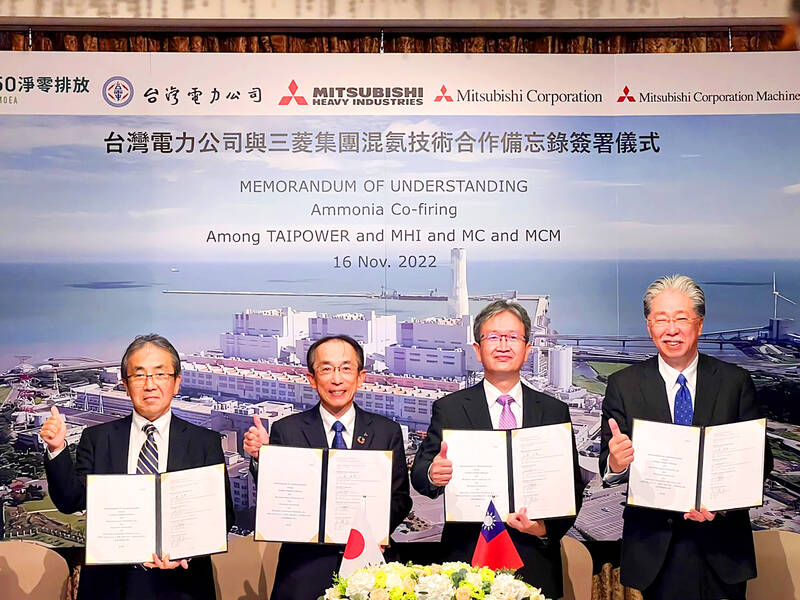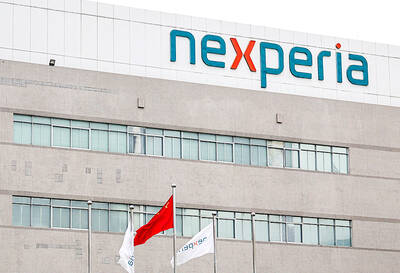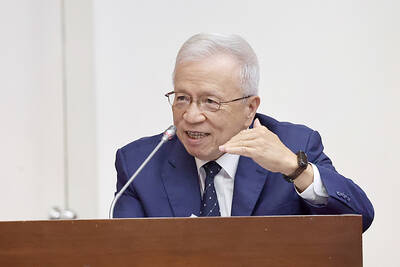State-run utility Taiwan Power Co (Taipower, 台電) yesterday signed a memorandum of understanding (MOU) with Japan’s Mitsubishi Group to conduct a demonstration project that involves mixing ammonia with coal to generate power at the Linkou Power Plant (林口發電廠) in New Taipei City.
The project aims to achieve 5 percent cofiring of ammonia at the coal-fired plant by 2030 before increasing the use of ammonia to 20 percent, Taipower spokesman Wu Chin-chung (吳進忠) said.
If the 5 percent ammonia cofiring target is reached, it is expected to help the power plant reduce its carbon emissions by 9,000 tonnes per year, Taipower said.

Photo: Lin Jin-hua, Taipei Times
Emissions reduction in the power sector plays an important role in Taiwan’s efforts to reach its goal of net zero emissions by 2050.
Taipower continues to promote a coal-to-gas shift at coal-fired plants — which includes burning ammonia with coal — energy storage technologies and sources of renewable energy, Taipower president Wang Yao-ting (王耀庭) said during the signing ceremony.
Toshiyuki Hashi — chief executive officer of gas power at Mitsubishi Hitachi Power Systems Ltd, a power solutions brand — said that Taiwan and Japan face common challenges in fuel imports and development of renewable energy sources, adding that he believes through collaboration, the two countries can effectively foster and accelerate an energy transition.
Hiroki Haba, chief operating officer at Mitsubishi Corp’s Next Generation Fuels & Petroleum business division, said that the group plans to spend ¥1.2 trillion (US$8.6 billion) to develop next-generation energy technologies.
As part of that approach, Mitsubishi Corp is seeking to make the ammonia-coal cofiring technology used in the demonstration project with Taipower more cost competitive, Haba said.

JITTERS: Nexperia has a 20 percent market share for chips powering simpler features such as window controls, and changing supply chains could take years European carmakers are looking into ways to scratch components made with parts from China, spooked by deepening geopolitical spats playing out through chipmaker Nexperia BV and Beijing’s export controls on rare earths. To protect operations from trade ructions, several automakers are pushing major suppliers to find permanent alternatives to Chinese semiconductors, people familiar with the matter said. The industry is considering broader changes to its supply chain to adapt to shifting geopolitics, Europe’s main suppliers lobby CLEPA head Matthias Zink said. “We had some indications already — questions like: ‘How can you supply me without this dependency on China?’” Zink, who also

At least US$50 million for the freedom of an Emirati sheikh: That is the king’s ransom paid two weeks ago to militants linked to al-Qaeda who are pushing to topple the Malian government and impose Islamic law. Alongside a crippling fuel blockade, the Group for the Support of Islam and Muslims (JNIM) has made kidnapping wealthy foreigners for a ransom a pillar of its strategy of “economic jihad.” Its goal: Oust the junta, which has struggled to contain Mali’s decade-long insurgency since taking power following back-to-back coups in 2020 and 2021, by scaring away investors and paralyzing the west African country’s economy.

BUST FEARS: While a KMT legislator asked if an AI bubble could affect Taiwan, the DGBAS minister said the sector appears on track to continue growing The local property market has cooled down moderately following a series of credit control measures designed to contain speculation, the central bank said yesterday, while remaining tight-lipped about potential rule relaxations. Lawmakers in a meeting of the legislature’s Finance Committee voiced concerns to central bank officials that the credit control measures have adversely affected the government’s tax income and small and medium-sized property developers, with limited positive effects. Housing prices have been climbing since 2016, even when the central bank imposed its first set of control measures in 2020, Chinese Nationalist Party (KMT) Legislator Lo Ting-wei (羅廷瑋) said. “Since the second half of

AI BOOST: Next year, the cloud and networking product business is expected to remain a key revenue pillar for the company, Hon Hai chairman Young Liu said Manufacturing giant Hon Hai Precision Industry Co (鴻海精密) yesterday posted its best third-quarter profit in the company’s history, backed by strong demand for artificial intelligence (AI) servers. Net profit expanded 17 percent annually to NT$57.67 billion (US$1.86 billion) from NT$44.36 billion, the company said. On a quarterly basis, net profit soared 30 percent from NT$44.36 billion, it said. Hon Hai, which is Apple Inc’s primary iPhone assembler and makes servers powered by Nvidia Corp’s AI accelerators, said earnings per share expanded to NT$4.15 from NT$3.55 a year earlier and NT$3.19 in the second quarter. Gross margin improved to 6.35 percent,